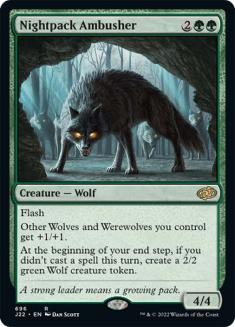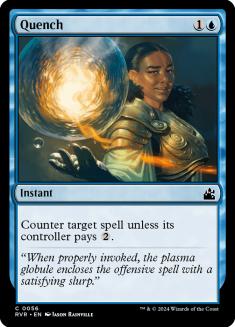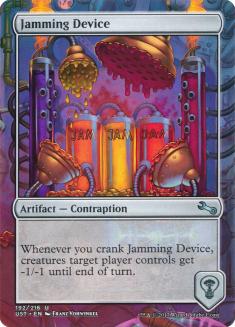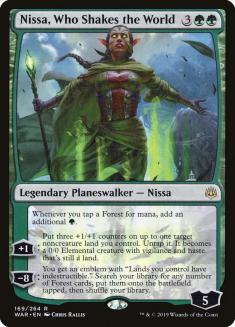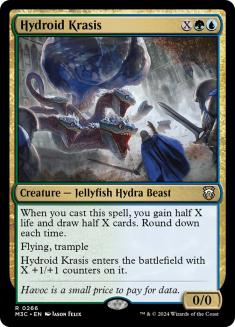The story of Mythic Championship VII last weekend was Simic Flash, a deck which ended up taking three of the Top 8 slots with only three total pilots in the field. If you’re planning to play a Standard event in the coming weeks, you need to be prepared to play against it.
Before we get too deep into doing that, let’s take a look at the new Public Enemy No. 1:
Creatures (15)
Planeswalkers (4)
Lands (26)
Spells (15)

This deck certainly has bad matchups, and I’m sure my many talented colleagues, alongside the hivemind, will explore them in detail. But Flash decks, more than any other archetype in Magic, can be exploited by changing the way you play against them in addition to how you build your deck. In this article, I will catalogue multiple in-game techniques for battling Flash decks along with a set of heuristics to help choose between them.
What Is a Flash Deck?
A Flash deck is any deck that plays predominantly at instant speed, featuring many counterspells. Unlike draw-go control decks, they feature proactive instant-speed elements, in Simic Flash’s case Brazen Borrower and Nightpack Ambusher. This puts the opponent in a bind where if they cast a spell, the Flash player will counter it, but if they don’t, the Flash player will advance their own battlefield. This flexibility comes at a cost: these decks are typically much less inevitable than a draw-go control deck and beating them in the late-game is possible if you manage to resolve key spells.
Making Their Counterspells Awkward
Your Simic opponent passes on the third turn without making a play. Both players have no nonland permanents. You untap, play your fourth land, and stare at the powerful Fires of Invention that will tie your entire draw together. If you cast it now, your opponent will almost certainly trade their counterspell for it, profitably utilizing their mana. If you cast nothing, they will most likely waste that mana. Even if they have one of their two copies of Brazen Borrower, they may not be interested in casting it without getting to bounce something first. Thus the right play in this spot is usually to not cast a spell.
The same Simic opponent plays a land and passes back on Turn 4, with the battlefield still empty and all of their lands untapped. If you pass again, they are likely to resolve Nightpack Ambusher at absolutely no cost. From that point, they will have little trouble leaving up countermagic for the rest of the game, and will have a threat that generates value with each passing turn. Thus, you should cast your spell into their four mana and force them to choose between countering it and casting Ambusher. This walks into Frilled Mystic, but that’s far less devastating than an uncontested Nightpack Ambusher.
If they do counter your Fires, then you should generally lean towards casting your spells for the next several turns to continue to make Nightpack awkward. Bear in mind that on five they can have Mystical Dispute and Ambusher and on six they can have Quench and Ambusher. If you can, play around those cheaper counterspells to force them to choose between Nightpack and letting your spells resolve each turn of the game.
The general principle here applies against almost all counterspell decks: when possible, cast your spells the first turn they have enough mana to be proactive on your end step.
Taxing Flash’s Mana
An easy way to fight against an opponent with counterspells is to hold back your spells when they have open mana, and set up a turn where you can cast multiple spells but they can only cast a single counterspell. Then, cast the first spell. If it resolves, you just pass the turn, having made progress on the battlefield. If it doesn’t, your second spell will.
Executing this demands either that your spells be cheaper than your opponent’s or that you have access to more mana. As a result, this should be your go-to plan whenever your opponent is missing land drops, or your hand is land-heavy and thus spell-light.
There are certainly exceptions, but I generally lean towards playing the cheaper spell first if it evades Quench and/or Mystical Dispute. That way, if they want to spend their mana, they’re forced to use a Sinister Sabotage. This plan is especially coherent when you’re land-heavy since then you stand a real chance of blanking the conditional counterspells for the entire game.
If you have instant-speed threats of your own, you can achieve a similar effect by casting a threat on their end step and then, if it gets countered, casting one on your main phase. In Standard, this will primarily come up in the Flash mirror, but it is a common play pattern across formats.
Get Ahead and Then Force Action
When a spell is countered, both players spend their mana and the battlefield does not change. This benefits whoever is ahead on the battlefield, as they can continue to force through damage, activate their planeswalkers, and progress their gameplan. Thus, if you get out ahead of a Simic Flash deck, the right strategy is typically to cast your spells, since them countering likely benefits you. This fundamental fact is why decks like Mono-Red and Mono-White have historically been strong against Flash strategies. They simply pull too far ahead before the Flash deck’s countermagic is online.
There are exceptions to this heuristic; for instance, if the way you’re ahead is that you’ve resolved a mana-intensive engine like Trail of Crumbs, you may want to invest mana into that to continue to accrue advantage.
How to Jam
When push comes to shove, you will often end up in spots where you just cast one spell a turn, cross your fingers, and hope something resolves. This isn’t as crazy as it sounds, since Simic Flash only has about fifteen counterspells, over half of which are in some way conditional. Because this plan requires that you present more threats than they have answers, it tends to be correct when you’re spell-heavy and land-light, since that will make it difficult for you to double-spell while also increasing the odds of you having more spells than they have counters. It also tends to be a good plan if the Flash player is spell-light, but I find this is hard to discern in-game: a player who hits their land drops but has a hand full of counterspells plays similarly to one with a hand full of lands.
When executing this plan, you have two main goals: blank as many of their conditional counterspells as possible, and ensure that, when your threats finally start resolving, they can win the game. Both imply that you should generally cast your cheapest, least impactful spells first. This plays around Quench and Dispute in the short run, while giving you time to draw lands and cast more expensive spells around them in the long run. It also makes your final, best spell the one that is most likely to resolve.
Nissa, Who Shakes the World
Most historical Flash decks have not contained a game-ending haymaker that operates at sorcery speed. In almost any matchup, Nissa can spiral out of control in a few turns and is extremely difficult to remove in combat. Thus, she adds an entirely new dimension to the Flash strategy. Often, playing around counterspells will mean slowing down your action and thus playing into Nissa, while minimizing Nissa’s impact will mean jamming all your spells into countermagic. When playing against this deck, I recommend that you first ask yourself if you have the luxury of playing around both at once. If the answer is no, playing around counterspells will almost always be correct, as they have far more counterspells than Nissas.
If the answer is yes, then you will need to prioritize holding up removal or countermagic on Turn 5 to answer Nissa before they can untap a land, as well as spending removal on Paradise Druid to delay her arrival. Ideally said removal is cast on their end of turn, or is so cheap that the threat of double-spelling prevents them from countering it. If you’re trying to beat a resolved Nissa, you should also err on the side of casting your spells, because you need an overwhelming battlefield advantage before the fifth turn.
Hydroid Krasis
The only playable uncounterable effect in Standard is Krasis. In general, it is best to cast uncounterable effects on a turn when the Flash player has a lot of mana untapped, since that prevents double-spelling from being effective. In this situation, making forward progress with an uncounterable effect is far superior to either doing nothing or casting a weaker spell.
However, this decision is far more complex in the case of Krasis, since it gets better the longer the game goes. There’s a lot of nuance here, but the deciding factor in whether to cast Krasis or not on a given turn is often Nissa. If you’re trying to beat Nissa, cast the Krasis immediately. If not, wait as long as you have a good chance of drawing an additional card and something to do in the meantime. Having Krasis in your hand and enough land to utilize it generally means you should lean toward the jam plan, as the Simic deck has relatively few ways to generate card advantage.
***
When trying to improve a matchup, there are three techniques you can utilize: changing decks, changing flex slots, and changing the way you play the games. I hope this article has armed you with the tools to utilize that third option to maximally improve your Flash matchup without changing a card. Playing against Flash decks is usually a dance, but now you know the steps.

